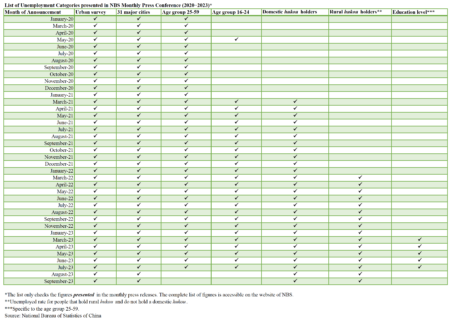New Statistics amid Youth Employment Crisis?
In his book Trust in Numbers, Ted Porter said that journalists and officials “have very limited ability” to rework the contingent statistical categories into different ones. This observation could strike a chord with those who saw how Western news (and Chinese social media) responded to China’s decision to suspend its monthly report of the age-specific unemployment rate. Although Fu Linghui, the National Statistical Bureau (NBS) spokesperson, said that they wish to “optimize” the category based on China’s development, no timetable for the new method was given. Meanwhile, major media outlets immediately attributed the suspension to the unemployment rate of Chinese youth (16-24), which has risen to a disturbing level of over 20% in April.
Since its introduction in 2018, the age category has been integral to the urban unemployment survey, a method in line with the international standard. NBS has always been comfortable sharing the monthly figures in its press conferences. In July 2018, the unemployment rate for people aged 25-59 was one of the four numbers NBS listed to summarize the survey. In 2021, NBS began to include the rate for people aged 16-24. This year, the bureau even took the initiative to divide the unemployed into different education levels (see the attached list). In contrast to the previous transparency, the decision to withdraw data from the public realm looks abrupt, giving more reasons for people to speculate on the underlying politics. One popular theory was that the age-specific category got internalized because it was incompatible with the state narrative of China’s vigorous economic rebound after COVID-19.
In defending China’s economic stability, Fu Linghui implied that the high youth unemployment rate could come from students’ extended education period. However, his example led to more questions about the survey approach. For instance, it is now uncertain whether NBS’s previous survey had included students in its calculus. To check the methodology, republished on an official pamphlet this year, students were never explicitly excluded, as an “employed” individual is defined as one who has worked in gainful employment for at least one hour in the week before the survey. Such a requirement is not a high threshold, even for youth in education and vocational training. To show better figures, the previous survey could have included students (and other underemployed people) in the pool of “employed.” The unemployment rate is calculated by dividing the unemployed by the total number of employed and unemployed people. Likewise, one can also challenge the definition of unemployment, which requires an individual to have actively sought jobs in the past three months. Such a method may have underestimated the youth unemployment rate because it excluded what OCED defined as NEET group, meaning “young people who are not in employment, education or training.” This group is especially relevant to the Chinese context because its young population increasingly celebrated the lifestyle of “lying flat (tangping 躺平)” and thereby not active in job-seeking. According to Chinese economist Zhang Dandan, when the NEET group was reincorporated, China’s youth unemployment rate could already be 46.5% in March this year.
To go back to Porter’s observation, it appears that the statistical categories created out of contingency in Western societies have worked in China’s “favor” despite NBS’s wish to renew them. Creating youth unemployment statistics to support the narrative of China’s vigorous post-COVID rebound would then require much recalibration. When novel statistical categories emerge, the Chinese authority still needs extra effort to convince its audiences that they are representative. However, it is beyond the realm of Chinese statistics to determine whether these tasks are more arduous than confronting and tackling the intricate problems of youth unemployment.
(posted by Gus Tsz-kit Chan)

